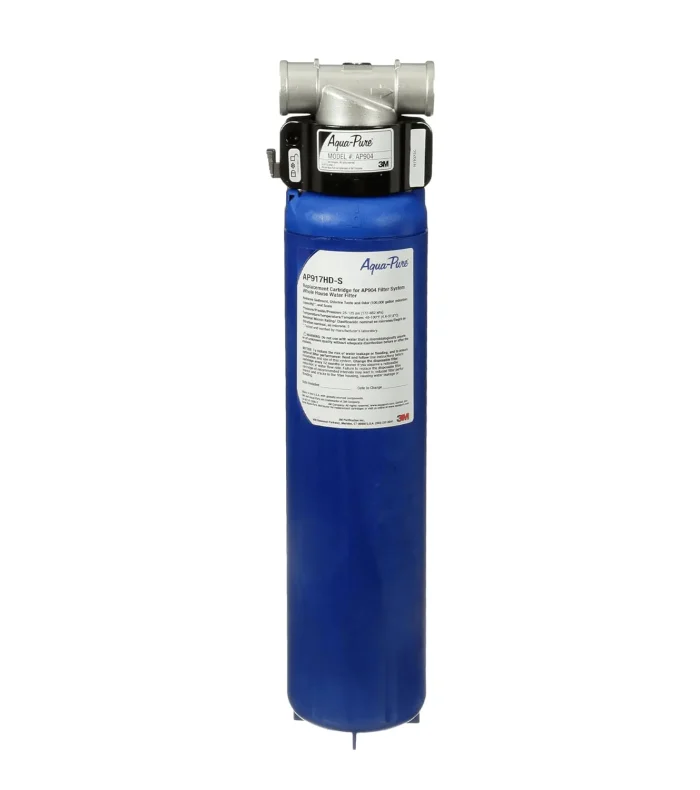A home water filtration system not only improves the purity and taste of your drinking water but can also increase the value of your home. These systems are usually installed where water enters your home, filtering out chemicals, heavy metals, minerals, and other contaminants. Small systems can be installed at specific points, such as your kitchen sink, for targeted filtration to purify water from that source only.
With so many options available, choosing the right system depends on your needs. Our top pick, the Aqua-Pure Whole House Water Scale Reduction System, is versatile enough for many homeowners. We’ve selected the best home water filtration systems for different situations and included helpful tips to guide your decision-making process.
Our Top Picks
Best Overall:
Jump to Review ↓
Best Advanced:
Jump to Review ↓
Best for Well Water:
Jump to Review ↓
Best for Hard Water:
Jump to Review ↓
Easiest To Install:
Jump to Review ↓
Best for small Homes:
Jump to Review ↓
Aqua-Pure Whole House Water Scale Reduction System »
Aquasana Rhino Well Water With UV »
iSpring Whole House Central Water Filtration System »
Waterdrop G3 Reverse Osmosis Water Filter System »
iSpring Three-Stage Whole House Water Filtration System »
iSpring Five-Stage Reverse Osmosis Water Filter System »
Our top pick is the Aqua-Pure Whole House Water Scale Reduction System (model AP904), mostly because of its adaptability. It’ll more than suffice for the majority of houses seeking to filter modest pollution. With maximums of 20 gallons per minute (GPM), its 10-gallon flow rate will meet most demands without causing a significant pressure decrease, but if more than three faucets or fixtures are in use at once, it may become sluggish. With an estimated filter life of 100,000 gallons, or around a year, the activated carbon filter has a 5-micron rating, which allows it to remove mild pollutants such as dust, rust, scale, and chlorine.
It’s one of the easiest systems to install, needing only a few simple instruments and plumbing components. Nevertheless, you will still need to cut a pipe and conduct some soldering, so if that’s outside your skill level, you should probably employ a plumber. Additionally, changing the filters is as simple as it gets: just unscrew them by hand and replace them. It won’t remove heavier metals like lead or more harmful pollutants, but it will work for the majority of homes to provide soft, tasteless water.
Specs
CONS:
PROS:
Filtration:
Number of Stages:
Flow Rate:
Buy From Amazon »
Activated Carbon
10-20 GPM
1
- Short filter lifespan
- Not made for severe contamination
- Quality filtration at a good price
- Simple installation
- Excellent sanitation
- Long Lasting
iSpring Whole House Central Water Filtration System »
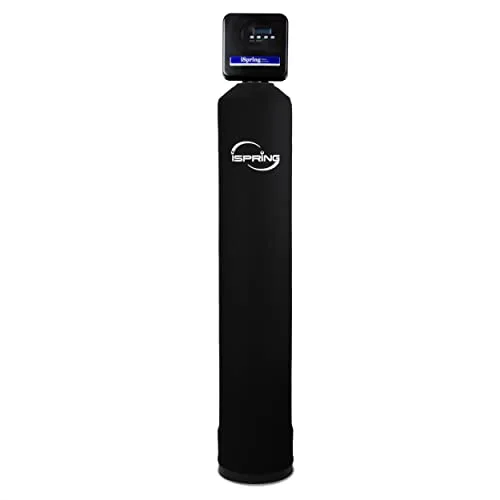
PROS:
- Expensive
- Not for hard water
- High amount of flow rate
- Excellent filtration
- Upto 10 years without maintenance
To get modern, almost maintenance-free filtration, you might consider the iSpring Whole House Central Water Filtration System (model WF150K), which is ideal for big homes with significant water usage. The dual stages of filtration in this formidable system are capable of getting rid of mercury, lead, chlorine, unpleasant odors, and tastes, and pretty much everything else that isn’t water. Its enormous 26-gallon-per-minute flow rate also makes it possible to pressurize numerous fittings at once. Its Set and Forget Smart Valve auto-cleaning feature, however, which lets you go between five and ten years without changing filters or doing any maintenance, is what sets it apart.
It’s not little, but it’s not tiny either; it’s roughly the size of a double-sized dive tank. It’s also very expensive. Although not too difficult to install, some plumbing knowledge and handyman skills are helpful. Keep in mind that it isn’t a water softener, and even though it can lessen the minerals that create hard water, you might still need to install a second softener to satisfy your needs. However, this system is hard to match for a nearly free-of-maintenance way to enjoy pure drinking water.
Specs
CONS:
Filtration:
Number of Stages:
Flow Rate:
Buy From Amazon »
Granular activated carbon
26 GPM
2
Aquasana Rhino Well Water With UV »
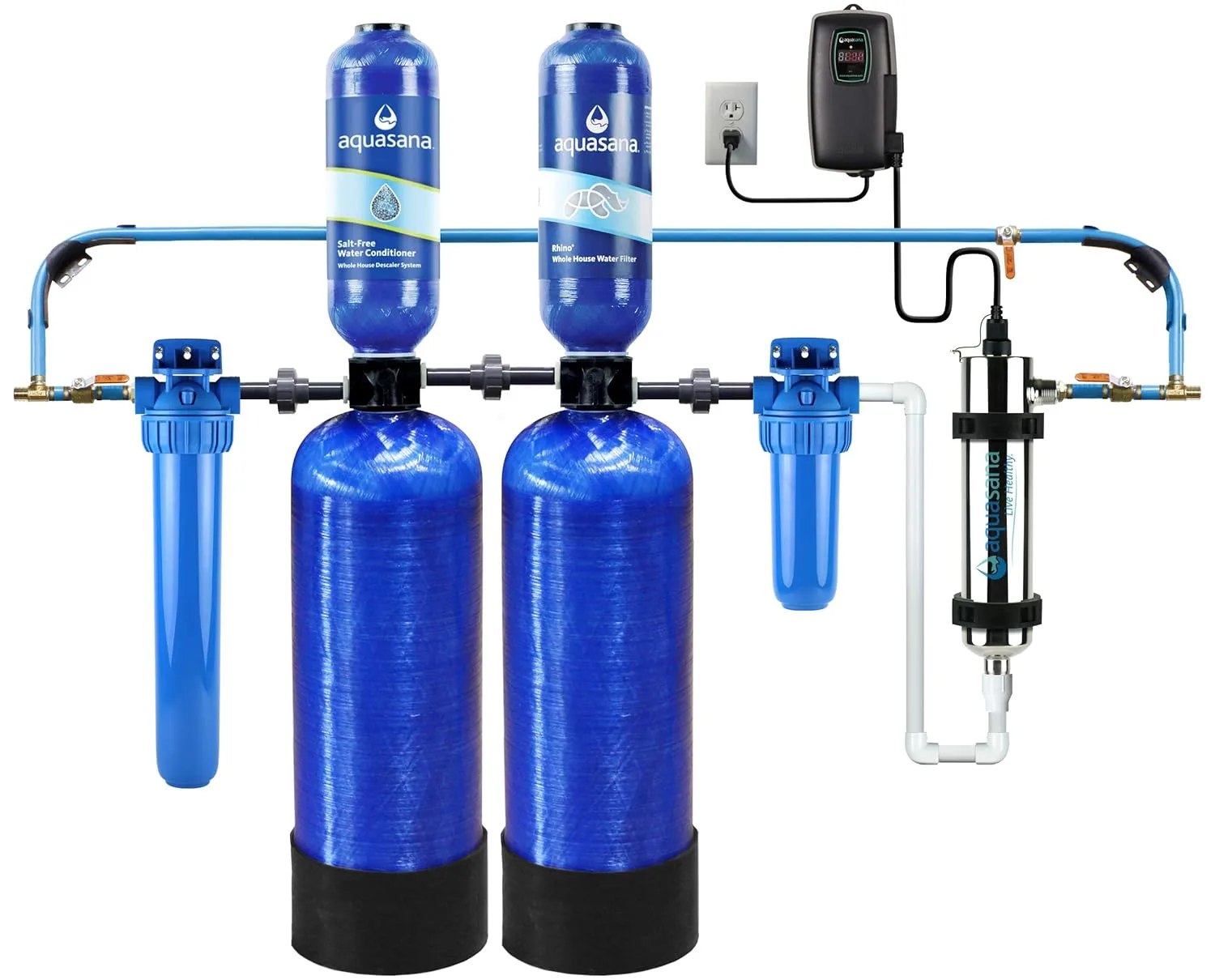
PROS:
- Installation can be tricky
- Moderate flow rate for such a large system
- Effective well water treatment
- Ultraviolet (UV) treatment
- Easy maintenance
CONS:
Whenever it comes to well water filtration, you should usually go above and above because private well water may contain impurities that are normally removed at a treatment plant. You may drink with confidence with this Aquasana system since it has multistage carbon filtration along with a UV filter that eliminates viruses, bacteria, and aquatic cysts.
Although some customers have complained that the system can be challenging to set up, once installed, it’s simple to maintain and change the main filters. The pre-and post-stage filters have an easy screw-off/screw-on replacement method; they should be changed every two months, but the primary filters only need to be changed every 500,000 gallons or five years. Additionally, by stopping the growth of germs and algae, the Rhino’s Copper-Zinc filter lowers the requirement for clearing and other management. Its maximum flow rate of 14.7 gallons per minute may be a little low for a system this size, but it’s still more than plenty to run several fixtures at once. Overall, this filter offers more than enough sanitization to remove any potential contaminants from your well water.
Specs
Filtration:
Number of Stages:
Flow Rate:
Buy From Amazon »
Carbon, Copper-Zinc, and UV
14.7 GPM
5
iSpring Three-Stage Whole House Water Filtration System »
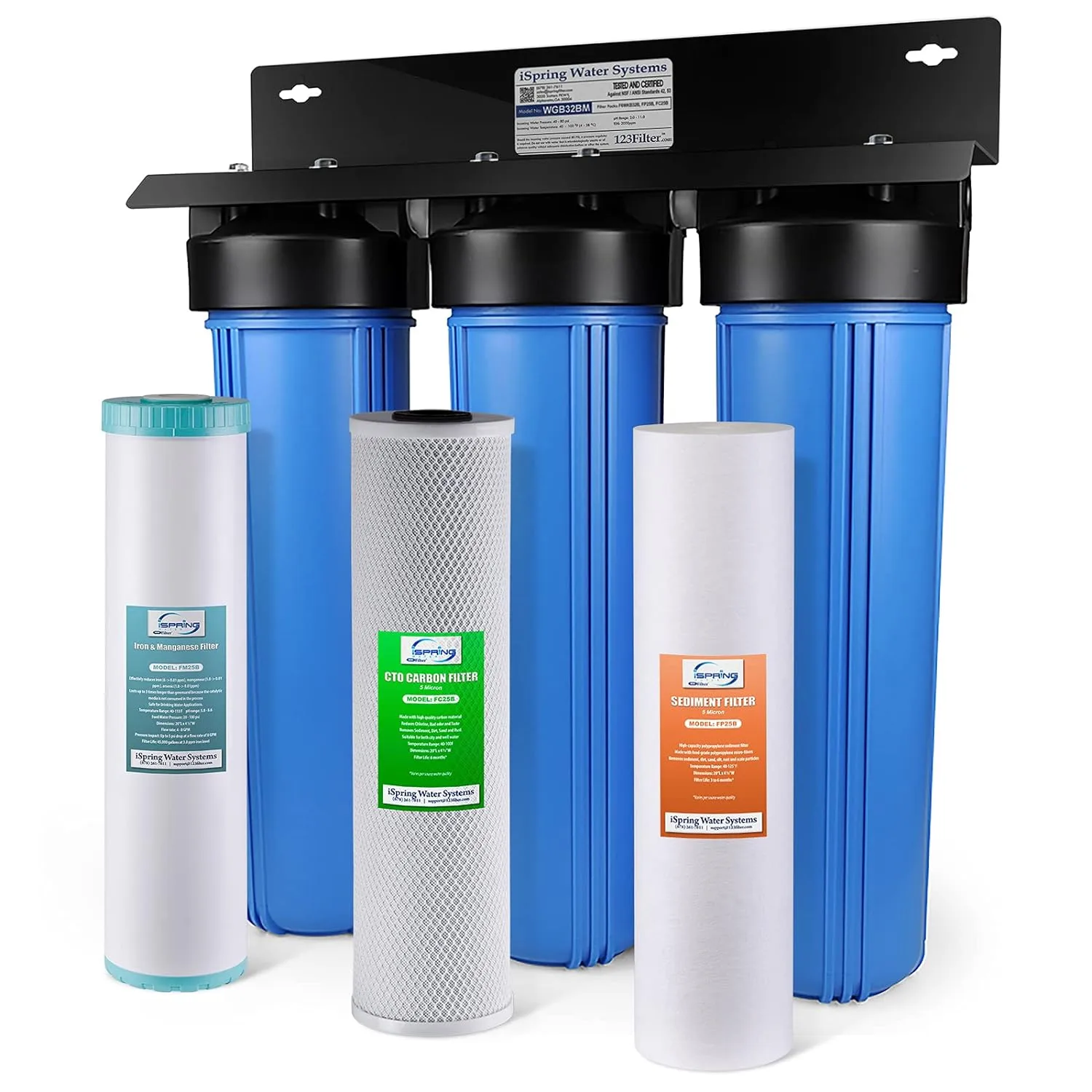
PROS:
- Installation requires some handiness
- Some buyers report leakage
- Very effective hard water treatment
- Easy maintenance
- Outstanding customer service
CONS:
This iSpring Three-Stage Whole House Water Filtration System can perfectly soften your water. Its purpose is to remove minerals such as iron and manganese, but it also gets rid of silt, chlorine, industrial solvents, fertilizers, herbicides, rust, and more. The water it creates is clean-tasting and smells good. Water is supplied to many fixtures at a rate of 15 gallons per minute without experiencing a loss in pressure; however, bear in mind that adding a washing machine would likely cause a fall in pressure.
Although buyers indicate that the installation is very simple, some tools, parts, and some know-how are needed. The screw-off filters last for around a year or 100,000 gallons, and maintenance is simple. The provider is renowned for offering top-notch client support. Although a small number of users complain about leaks near the filters, most owners are content with their softer, clearer water.
Specs
Filtration:
Number of Stages:
Flow Rate:
Buy From Amazon »
Mechanical, chemical absorption, and ion exchange
15 GPM
3
Waterdrop G3 Reverse Osmosis Water Filter System »
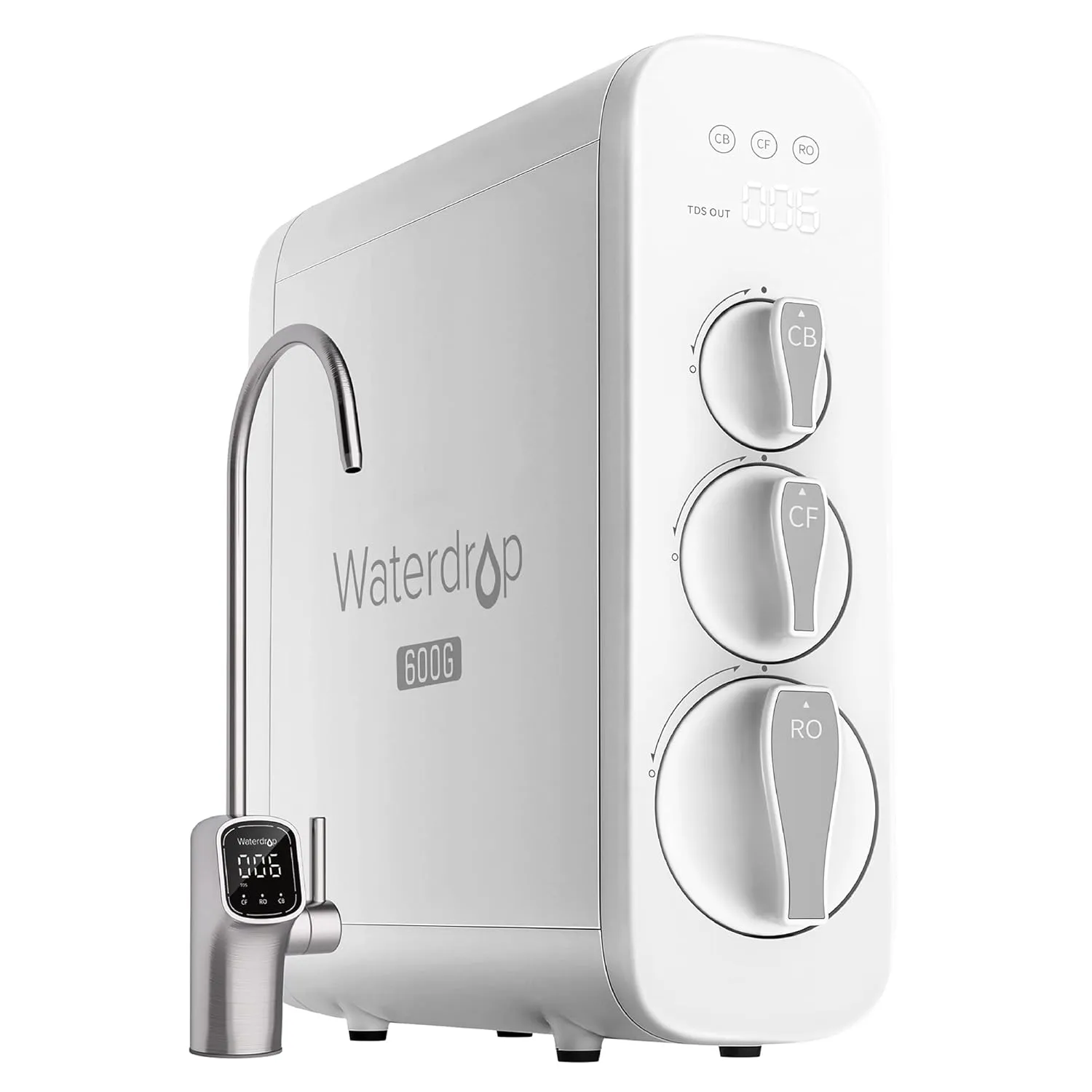
PROS:
- Single faucet only
- Pricey for just one faucet
- Very easy to install
- Easy maintenance
- removes extremely harmful materials
CONS:
The G3 Reverse Osmosis Water Filter System from Waterdrop is widely regarded by thousands of reviews as being simple to install and maintain. This is due in part to the fact that it is an under-sink, single-point unit that only needs a basic waterline, as well as the fact that the manufacturer has included straightforward instructions and minimal parts and tools are required. An LED display shows the water quality and filter life, and changing filters is simple.
But keep in mind that this is just a faucet filter and isn’t intended to be used across your whole home. You may use it to get filtered water from your kitchen tap whenever you want but don’t expect it to do anything else. Its reverse osmosis filtration system is not only effective but also highly efficient, utilizing less water while reducing highly toxic contaminants like chlorine, total dissolved solids (TDS), PFAS, chromium, radium, fluoride, radioactive substances, and more. Its tankless design takes up very little space.
Specs
Filtration:
Number of Stages:
Flow Rate:
Buy From Amazon »
Reverse osmosis and carbon block
400 Gal per day
8
iSpring Five-Stage Reverse Osmosis Water Filter System »

iSpring Five-Stage Reverse Osmosis Water Filter System
iSpring Five-Stage Reverse Osmosis Water Filter System
PROS:
- Single faucet only
- Low flow rate
- Space saver
- Excellent filtration
- Simple maintenance and installation
CONS:
The iSpring Five-Stage Reverse Osmosis Water Filter System is a space-saving under-sink installation option that offers exceptional filtration power, making it the perfect choice for small homes. Its single-tap limitation is a drawback, but its ability to filter out nearly anything you could want makes up for it. Its multistage reverse osmosis filter removes lead, PFAS, chlorine, fluoride, arsenic, hard minerals, and much more.
It’s not too difficult to install and maintain, and the company’s customer assistance is generally good and fast. Additionally, homeowners express satisfaction with the way the supplied kitchen tap looks. Even for a single-point system, the flow rate is a little low, but the filtration quality is excellent.
Specs
Filtration:
Number of Stages:
Flow Rate:
Buy From Amazon »
Reverse osmosis, carbon block, activated carbon
75 Gal per day
5
The Bottom Line
According to research, the type of water supply in your home dictates the filtration needs. Normally, most houses would benefit from those capable systems that can reduce silt, rust, dust, and chlorine. High-performance filters are not always necessary, however, unless the water is highly contaminated. Testing the water before buying a filtering system is important to determine how much treatment it needs and avoid overspending on features that you do not need. For some, the Aqua Pure Whole House Scale Reduction System worked great, capable of removing medium-level impurities and improving water quality.
Things to Consider When Buying Home Water Filtration Systems
Filter Type: “Different contaminants need different solutions,” continues Ethan Bennett, senior technical advisor at Sanders & Johnson in Colorado. That would then call for various filters, based on the problem. Carbon filters, if your water contains a great deal of chlorine or rust. Reverse osmosis for minerals or heavy metals. For hard water, ion exchange will soften it. For bacteria and viruses, use a UV filter.
These can also be achieved through pre- or post-filters, which reduce sediment that can build up in appliances. Some of the advanced systems include multiple types of filters for better protection.
“I would recommend starting with a home water test,” says Robert Erickson, director of operations at Leaf Home Water Solutions. While you can purchase home testing kits at hardware stores or online, Erickson suggests professional testing or contacting your local health department for accurate results.
Flow Rate: A system’s flow rate refers to the speed at which water passes through it. However, it is mostly specified in GPM for whole-house systems or in GPD for single-sink systems. According to Ethan Bennett, when using a lot of water in a household, a flow rate of at least 10-15 GPM should be obtained.
First, you need to estimate the largest flow that may be required at any time by a system before you can ensure that its flow rate will satisfy your requirements. For example, add a few flow rates for some fixtures together in a house: Shower: 1.5-3 GPM; Faucet: 2-3 GPM; Toilet: 2-3 GPM; Washing machine: up to 5 GPM.
Knowing what flow rate you need is important to have a system that efficiently supplies water throughout your home, so the water filtration performance is at its best.
Installation and Maintenance: Most home water filtration systems are relatively easy to install and require you to connect them to the waterlines. However, some may require cutting and re-routing of the pipes, which involve specialized tools. If this sounds challenging, then consider hiring a plumber.
Nearly all filter systems require some type of maintenance, whether it is changing the filters every two to 12 months. Most systems also require periodic cleaning, although some have auto-cleaning features that alleviate this task to some degree.
How to Choose the Best Whole House Water Filter System for Your Home?
The whole house water filter system is designed to provide you with filtered water everywhere in your home. You can have filtered drinking and cooking water, but you will also get filtered water in your shower, washing machine, and other appliances using water. Here are some tips to help you choose the perfect filtration system for your home.
Water Softener Pairing: If you have hard water, it is desirable to soften and filter your water. Check a whole-house water filter system that can be matched with a water softener or a salt-free water conditioner. This will yield the advantages of filtered water and the reduction of scale, solving once and for all the problems related to hard water.
Filtration Options: When purchasing a whole house water filtration system, you’ll want to be aware of their filtration type. Ensure that whatever one you choose provides what you need to achieve your water quality targets. Many systems remove dangerous contaminants; however, others also eliminate microorganisms. Some of these systems accomplish this with a prefilter, carbon block post-filter, or ultrafiltration membrane—on their own or in some combination.
Improving pH Levels: If you are concerned about the water’s pH levels, consider whole-house water filter systems that adjust the levels of pH in water. These increase the alkalinity of water, hence reducing its acidity to protect your family, pets, appliances, and pipes, while at the same time improving the taste and quality of water.
Flow Rates: Different whole-house water filter systems are designed with different flow rates that suggest the velocity at which the system will filter the water. Most homes will be just fine with a standard system, but if you have a large estate, bed, and breakfast, boarding house, multi-family complex, or any high-water demand situation, you will want a system that will do from 15 to 35 gallons per minute.
Filter Media: The part of the system that filters out the impurities is the filter media. You can go for Eagle filters, Smart multimedia filters, or any other type. Some of the common ones available to you would be activated carbon, which binds the toxins and removes them, catalytic carbon to remove chloramine, kinetic degradation fluxion (KDF) which uses copper and zinc to remove heavy metals, and reverse osmosis membranes to remove harmful impurities such as asbestos and hexavalent chromium. Mixed media systems can be designed with any combination of these filters.
Ready to Upgrade Your Home's Water Quality?
Ready to enjoy all the benefits of filtered water throughout your home? Want the soap to work better when you’re in the shower, and for this limescale buildup on your appliances to be gone? Are you looking to improve the quality of your family’s drinking water?
Then click on your favorite whole-house water filter system above and buy it now to start experiencing cleaner and healthier water today!

